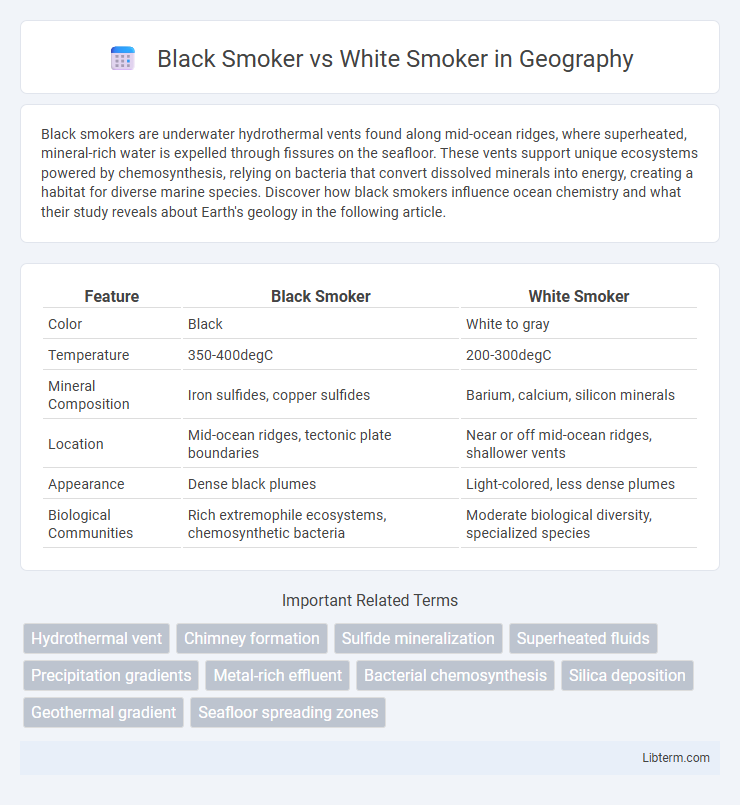Black smokers are underwater hydrothermal vents found along mid-ocean ridges, where superheated, mineral-rich water is expelled through fissures on the seafloor. These vents support unique ecosystems powered by chemosynthesis, relying on bacteria that convert dissolved minerals into energy, creating a habitat for diverse marine species. Discover how black smokers influence ocean chemistry and what their study reveals about Earth's geology in the following article.
Table of Comparison
| Feature | Black Smoker | White Smoker |
|---|---|---|
| Color | Black | White to gray |
| Temperature | 350-400degC | 200-300degC |
| Mineral Composition | Iron sulfides, copper sulfides | Barium, calcium, silicon minerals |
| Location | Mid-ocean ridges, tectonic plate boundaries | Near or off mid-ocean ridges, shallower vents |
| Appearance | Dense black plumes | Light-colored, less dense plumes |
| Biological Communities | Rich extremophile ecosystems, chemosynthetic bacteria | Moderate biological diversity, specialized species |
Introduction to Hydrothermal Vents
Hydrothermal vents are underwater fissures emitting geothermally heated water rich in minerals and chemicals, crucial for unique deep-sea ecosystems. Black smokers eject superheated, mineral-laden fluids primarily containing iron sulfides, which precipitate as dark, particle-rich plumes. White smokers release cooler, silica- and barium-rich fluids, forming lighter-colored mineral deposits like barite and anhydrite around vent openings.
Defining Black Smokers and White Smokers
Black smokers are hydrothermal vents found on the ocean floor that emit superheated water rich in minerals like iron sulfides, giving the vent fluids a dark, smoke-like appearance. White smokers release cooler, mineral-laden fluids containing barium, calcium, and silicon, which create lighter, white-colored plumes. Both vent types play crucial roles in deep-sea ecosystems by supporting unique biological communities dependent on chemosynthesis.
Formation Processes of Black Smokers
Black smokers form at mid-ocean ridges where seawater penetrates the oceanic crust, heats up from underlying magma, and becomes superheated hydrothermal fluid rich in dissolved metals and sulfides. This fluid then rises through fissures and vents, rapidly cooling upon contact with the near-freezing seawater, causing metal sulfides like iron and copper to precipitate and create the characteristic black chimney structures. The formation process involves complex chemical reactions and mineral deposition driven by temperature gradients and fluid-rock interactions beneath the seafloor.
Formation Processes of White Smokers
White smokers form when hydrothermal fluids rich in barium, calcium, and silicon exit the seafloor at moderate temperatures ranging from 250degC to 300degC. The mixing of these cooler fluids with seawater causes the precipitation of light-colored mineral deposits such as anhydrite, barite, and silica. These deposits create characteristic white plumes contrasting with the hotter, metal-rich black smokers formed by high-temperature venting.
Chemical Composition Differences
Black smokers emit hydrothermal fluids rich in iron sulfides, resulting in dark-colored chimneys due to precipitation of iron and sulfur compounds. White smokers release cooler fluids containing barium, calcium, and silicon, forming lighter-colored chimneys primarily composed of calcium sulfate minerals like anhydrite. The distinct chemical composition of black smokers versus white smokers reflects variations in temperature and mineral solubility, influencing the types of metal sulfides versus sulfate minerals deposited around these hydrothermal vents.
Temperature Variations and Effects
Black smoker vents expel hydrothermal fluids at temperatures often exceeding 350degC, resulting in mineral-rich, sulfur-laden black plumes due to the precipitation of metal sulfides like iron and copper. White smokers release cooler fluids, typically between 200degC and 300degC, characterized by lighter-colored plumes containing barium, calcium, and silicon minerals, which promote the formation of sulfates and carbonates. These temperature differences directly influence the chemical composition and biological communities around the vents, with black smokers supporting thermophilic archaea and bacteria adapted to extreme heat, while white smokers host organisms tolerant of comparatively moderate temperatures.
Biological Communities Around Smokers
Black smokers host dense biological communities dominated by thermophilic bacteria and archaea that thrive on hydrogen sulfide emitted from the vents, supporting complex ecosystems including tube worms, clams, and shrimp. White smokers emit cooler, silica-rich fluids that foster unique microbial mats and support species adapted to lower temperatures and different chemical compositions, such as various types of crabs and different microbial consortia. Both habitats provide chemically rich environments where chemosynthesis, rather than photosynthesis, drives primary production, sustaining diverse and specialized biological communities.
Locations and Geographic Distribution
Black smokers primarily form along mid-ocean ridges, such as the East Pacific Rise and the Mid-Atlantic Ridge, where tectonic plates diverge and hydrothermal vents discharge mineral-rich, superheated water. White smokers are commonly found in areas with lower-temperature venting, like the Lost City Hydrothermal Field on the Mid-Atlantic Ridge, characterized by alkaline fluids and carbonate chimneys. The geographic distribution of black and white smokers reflects variations in geological settings, tectonic activity, and the chemistry of vent fluids along divergent plate boundaries and subseafloor fault zones.
Scientific Importance and Discoveries
Black smokers emit superheated water rich in dissolved metals like iron and sulfides, fostering unique chemosynthetic ecosystems critical for studying extremophiles and biogeochemical cycles. White smokers release cooler fluids containing barium, calcium, and silicon, offering insights into mineral precipitation and hydrothermal alteration processes on the seafloor. Scientific discoveries from both vent types have advanced understanding of life's adaptability, mid-ocean ridge geology, and potential analogs for extraterrestrial life environments.
Black Smoker vs White Smoker: Key Differences and Implications
Black smokers emit dark, mineral-rich fluids at temperatures around 350-400degC, forming sulfide chimneys that support unique chemosynthetic ecosystems. White smokers release cooler fluids, typically between 200-300degC, rich in barium, calcium, and silicon, leading to the formation of lighter-colored chimneys composed mainly of barium sulfate. These differences in temperature and chemical composition significantly influence the diversity and types of microorganisms thriving around each vent type, impacting oceanic nutrient cycles and deep-sea biological communities.
Black Smoker Infographic

 libterm.com
libterm.com